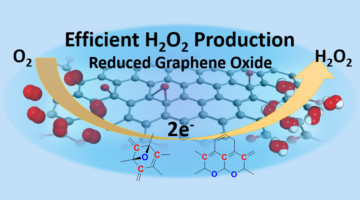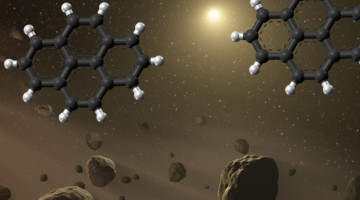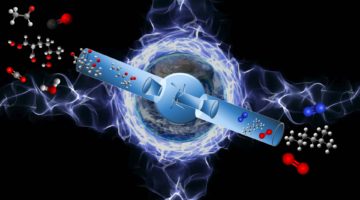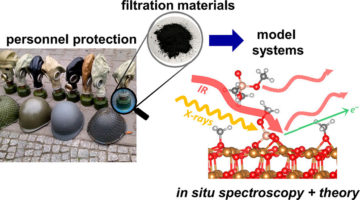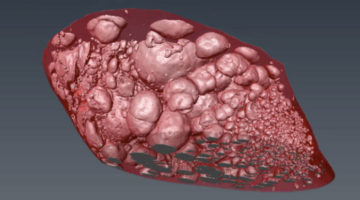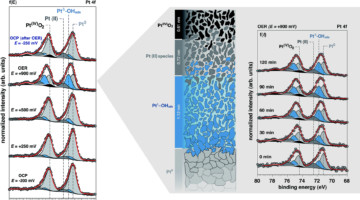Saturn’s largest moon, Titan, has a nitrogen-rich atmosphere, the formation of which has been the source of some scientific debate. Researchers have zeroed in on a low-temperature chemical mechanism that may have driven the formation of multiple-ringed molecules—the precursors to more complex chemistry now found in the moon’s brown-orange haze layer. Read more »
Graphene-Based Catalyst Improves Peroxide Production
Scientists characterized a graphene-based electrocatalyst that potentially makes the production of hydrogen peroxide more selective, efficient, and cost effective. Hydrogen peroxide is an important commodity chemical with growing demand in many areas, including the electronics industry, wastewater treatment, and paper recycling. Read more »![]()
![]()
From Moon Rocks to Space Dust: Berkeley Lab’s Extraterrestrial Research
Berkeley Lab has a well-storied expertise in exploring samples of extraterrestrial origin. This research—which has helped us to understand the makeup and origins of objects within and beyond our solar system—stems from long-standing core capabilities in structural and chemical analyses and measurement at the microscale and nanoscale. Read more »
Chemical Sleuthing Unravels Possible Path to the Formation of Life’s Building Blocks in Space
Experiments retrace the steps leading to the creation of complex hydrocarbons in space, showing pathways to forming 2D carbon-based nanostructures in a mix of heated gases. The study could help explain the presence of pyrene, a polycyclic aromatic hydrocarbon, and similar compounds in some meteorites. Read more »
Unraveling the Complexities of Auto-Oxidation
Researchers directly observed the formation of highly oxygenated molecules—the elusive products of auto-oxidation reactions relevant to combustion and atmospheric chemistry. A better understanding of auto-oxidation mechanisms could lead to better engines, less air pollution, and improved climate models. Read more »![]()
![]()
Fuel from the Sun: Insight into Electrode Performance
The mechanisms limiting the performance of hematite electrodes—potentially key components in producing fuel from the sun—have been clarified in interface-specific studies under realistic operating conditions, bringing us a step closer to storing solar energy in chemical fuels. Read more »![]()
![]()
Studying Gas Mask Filters So People Can Breathe Easier
Scientists have put the x-ray spotlight on composite materials in respirators used by the military, police, and first responders. The results provide reassuring news about the effectiveness of current filters and provide fundamental information that could lead to more advanced gas masks as well as protective gear for civilian applications. Read more »
PepsiCo Explores Future Food Products at the ALS
Global food and beverage giant PepsiCo has been using ALS tomography beamline 8.3.2 to understand more about the chemical structure and behavior of their starch-based snack foods, with the goal of creating a whole new category of snacks that consumers cook at home in their own microwaves. Read more »![]()
Subsurface Oxygen Boosts Activity of Copper Catalysts
Scientists are seeking ways to reduce levels of CO2 in the atmosphere by improving the processes that convert CO2 gas into ethanol (a liquid fuel). But copper, the best catalyst for this, is not very efficient. Now, ambient-pressure x-ray experiments have revealed how subsurface oxygen boosts copper’s catalytic activity. Read more »![]()
![]()
A Closer Look at a Working Platinum/Electrolyte Interface
Ambient-pressure studies of the interface between a platinum electrode and an alkaline electrolyte revealed the molecular-level chemistry, structure, and dynamics of the platinum surface as a function of applied potential, highlighting differences between thermodynamic predictions and the actual surface composition. Read more »
- « Previous Page
- 1
- …
- 4
- 5
- 6
- 7
- Next Page »

